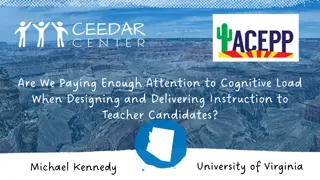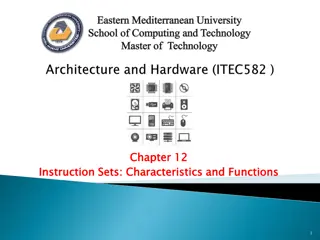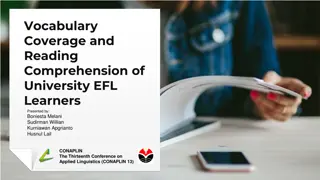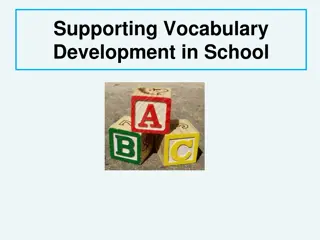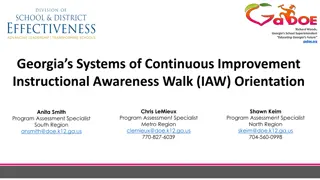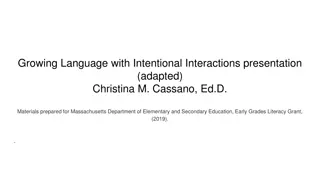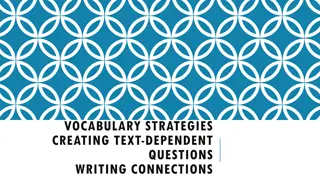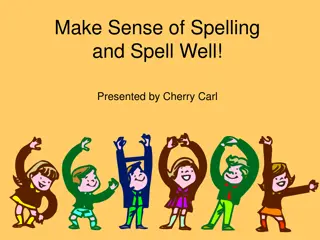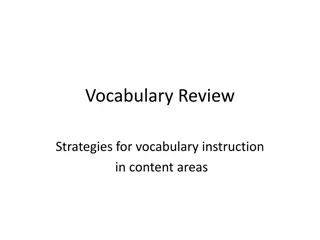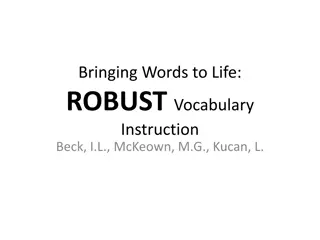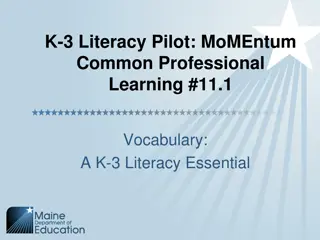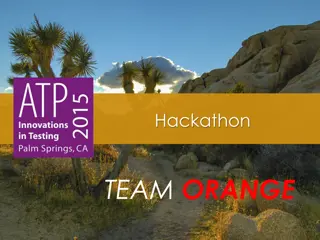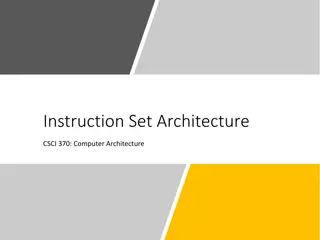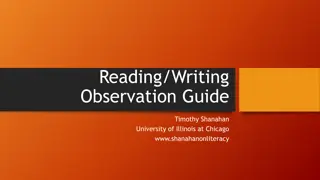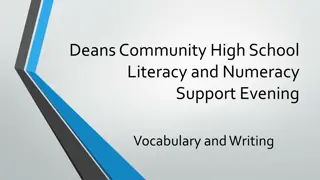Effective Vocabulary Instruction in Content Areas
Research indicates that vocabulary learning in content areas is a gradual process involving multiple meanings, affixes, and root words. Instruction should focus on explicit teaching methods like the PEAR framework, incorporating broad learning opportunities and student-friendly definitions. The preparation step involves selecting critical words, while the explanation step introduces terms with clear definitions.
Download Presentation

Please find below an Image/Link to download the presentation.
The content on the website is provided AS IS for your information and personal use only. It may not be sold, licensed, or shared on other websites without obtaining consent from the author.If you encounter any issues during the download, it is possible that the publisher has removed the file from their server.
You are allowed to download the files provided on this website for personal or commercial use, subject to the condition that they are used lawfully. All files are the property of their respective owners.
The content on the website is provided AS IS for your information and personal use only. It may not be sold, licensed, or shared on other websites without obtaining consent from the author.
E N D
Presentation Transcript
Razvijanje PREDMETNO SPECIFINEGA BESEDI A - nevarnost poenostavljanja http://www.cooperativeindividualism.org/calvin-on-scientific-law.gif http://www.cooperativeindividualism.org/calvin-on-scientific-law.gif http://www.cooperativeindividualism.org/calvin-on-scientific-law.gif Prim. Frayerjev model u enja/pou evanja strokovnega besedi a!
What RESEARCH tells us about vocabulary learning and teaching in content areas 1. Learning new words is a cumulative task that takes place gradually over time. 2. Words with multiple meanings are common in the content areas. 3. Affixes and root words need to be taught. 4. Words need to be taught in relation to other words. 5. Productive vocabulary instruction must extend beyond word definitions. Nagy & Scott, 2000
INSTRUCTIONAL FRAMEWORK Effective vocabulary instruction across subject-matter disciplines incorporates both broadly defined learning opportunities and explicit instruction in word-meaning acquisition. Broadly defined learning opportunities include the incorporation of wide reading in content classes as well as word consciousness. Explicit instruction: A structured lesson format using steps which are typically found in general lesson plan formats and also provide a framework for incorporating vocabulary. The steps include: (1) preparation, (2) explanation, (3) application, and (4) reinforcement (P.E.A.R.).
Step 1: PREPARATION In this step, teachers select the words to teach. These words and phrases should be those most critical to understanding the concepts in the passage or learning session and should be limited in number. Too many targeted words can be overwhelming to students, especially those who struggle with reading. This step also includes assessment of student background knowledge about the terms. One useful assessment tool is the knowledge rating scale (Blachowicz & Fisher, 2006): e.g. Content area: world geography I know this word (or term). It means . . . The word (or term) looks familiar. I do not know this word (or term). New information from the text Word (or term) urban urbanization urban sprawl
Step 2: EXPLANATION Once teachers have selected the vocabulary, the next step is to introduce the words and terms to the students using clearly understandable definitions what Beck and her colleagues call student-friendly definitions (Beck, McKeown, & Kucan, 2002). For example, for the term urban sprawl, instead of the definition the unplanned, uncontrolled spreading of urban development into areas adjoining the edge of a city, a more easily understood definition could be a word that describes what happens when a city starts spreading farther and farther out into the area around it. These student-friendly definitions also need to be accompanied by supportive instructional contexts (Graves, 2006). In this case, the teacher can show students various photographs that depict urban sprawl.
Step 3: APPLICATION After discussing the word meanings, students can then apply the words and terms in meaningful activities. These activities are designed to move students interaction with the words beyond the definitional level to higher levels of cognitive processing. The following questions and prompts require students to have a working knowledge of the words in order to provide reasonable answers (Beck et al., 2002): 1. Meaningful-use prompts (e.g. Things you would expect to see in an urbanized area) 2. Statement completions (e.g. Urbanization creates major changes in the landscape of an area because . . .) 3. Word associations (e.g. Which word is used when talking about renovating old warehouses in inner cities?) 4. Meaningful questions (e.g. Would you expect to find textile mills in a megalopolis?)
Step 4: REINFORCEMENT In this last step, teachers review newly learned words and terms to help students internalize word meanings. Writing activities that are interesting can serve to reinforce vocabulary. For example, the CUBING ACTIVITY (Bean, Readence, & Baldwin, 2008) illustrated below requires students to examine a concept from different dimensions. Students demonstrate their understanding of a term by describing, comparing, associating, analyzing, applying, and arguing for or against it. E.g. Term: Market economy Describe it. Compare or contrast it. Associate it. Analyze it. Apply it. Argue for or against it.
The Cubing Activity: Market Economy Describe it. Compare or contrast it. A market economy is similar to capitalism and free enterprise. A market economy is different from a planned or command economy in which the government decides what to buy and sell and at what price. A market economy is one type of economic system. An economic system is the way in which a country manages its money, materials, and labor. A market economy allows the people to freely choose what to buy and sell. Associate it. Analyze it. I think a market economy allows people the opportunity to earn more money by opening their own businesses. There is competition in a market economy, and this can keep prices down. The producers of goods and services listen to the wants and needs of the consumers. Apply it. Argue for or against it. I support a market economy. It gives me many choices when I am looking for things, and it gives me the opportunity to open my own business if I like. Every time I go shopping for a new video game, I can be grateful for the market economy in America. If it wouldn t be for this type of economy, I think the selection of games would not be as wide as it is at the stores.
The R.A.F.T Strategy Another example of reinforcement is the R.A.F.T. activity (Santa, Haven, & Harrison, 2008). R.A.F.T. stands for role, audience, form, and topic. Students select one of the writing tasks, and they use newly learned vocabulary in the writing. 1. Role of the Writer: Who are you as the writer? A movie star? The President? A plant? 2. Audience: To whom are you writing? A senator? Yourself? A company? 3. Format: In what format are you writing? A diary entry? A newspaper? A love letter? 4. Topic: What are you writing about?
The R.A.F.T Strategy: World geography Role Audience Lumber industry Format Topic Naturalist John Muir Meteorologist Commercial Conservation of natural resources Approaching category 4 hurricane Difficulties caused by the dam 3 most popular hiking trails in the United States 7-day tour of western Canada Request for more money to continue the expedition to the south People along the Texas Gulf Coast Broadcast script for television Salmon Grand Coulee Dam Outdoor enthusiasts Brochure Director of the National Park Service Tour director Page in a guidebook People who like to go on tours President Thomas Jefferson Internet website Lewis of Lewis and Clark Letter


